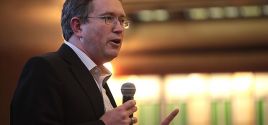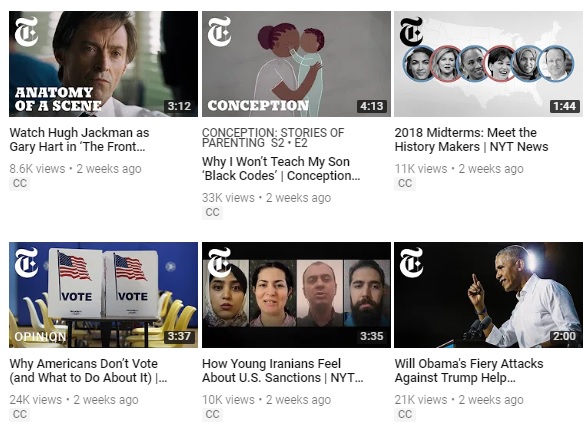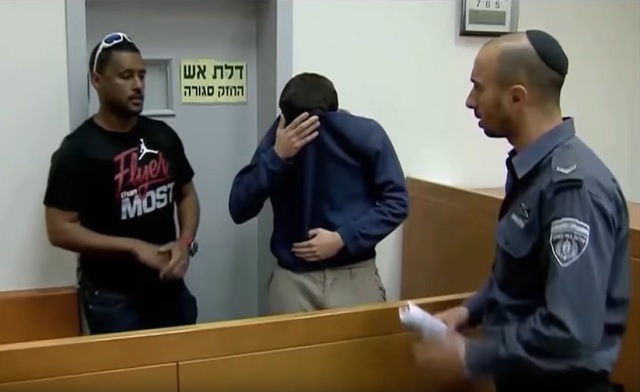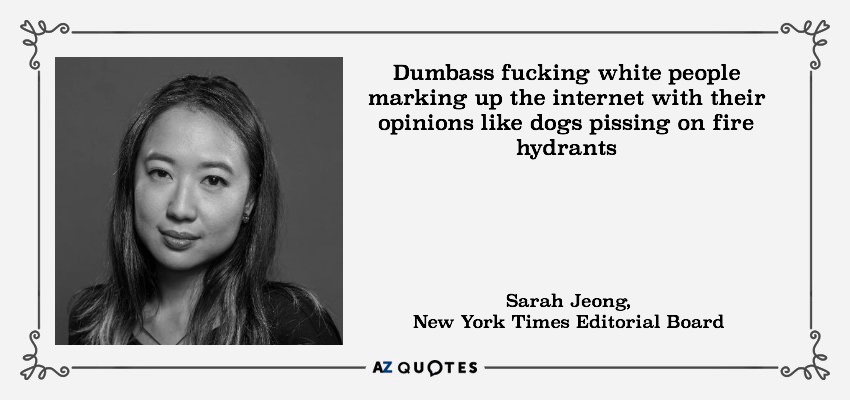NYT Editorial Board Compares Right-Wingers to Jihadists, Demands Censorship Of Social MediaChris MenahanInformationLiberation Nov. 26, 2018 |
Popular 
Trump Threatens War With Iran If No Nuclear Deal: 'There Will Be Bombing' Like They've 'Never Seen'

Rabbi Tells Senate Hearing It's 'Not Enough' to Be 'Not Anti-Semitic' - 'One Must Be Anti-Anti-Semitic'

Kentucky Rep. Thomas Massie Introduces 'Dual Loyalty Disclosure Act'

Sen. Schumer: 'My Job is to Keep the Left Pro-Israel'

Randy Fine, Who Celebrated Israel Killing An American Citizen, Struggling in Florida House Race
  The legacy media is furious they've lost control of the narrative and they're desperate to get it back by any means necessary. The legacy media is furious they've lost control of the narrative and they're desperate to get it back by any means necessary. Nationalist and populist movements are sweeping the globe due to open communication on the internet allowing the masses and anti-establishment leaders to do an end-run around the lying media. Though the media has seen a bump in their followers due to Trump's presidency as well as Google and Big Tech moving hard to censor their competition, they recognize the trend is still going against them so they're moving to shut it all down. The way they intend to do it is simple: accuse everyone of being "racists," "sexists," "bigots," "white supremacists," "neo nazis" and so on and demand regulations for "hate speech." Case in point: this piece released Saturday from the New York Times editorial board, where they push for hardcore, authoritarian censorship of the internet to stop the spread of "toxic ideas" and call for the US government and corporate America to team up to carry it out. They use fake stats from the ADL -- which they call "the most authoritative source" for documenting alleged hate incidents -- to make their case. From New York Times, "The New Radicalization of the Internet," subheadline, "Jihadists and right-wing extremists use remarkably similar social media strategies": Social media has played a key role in the recent rise of violent right-wing extremism in the United States, including three recent incidents -- one in which a man was accused of sending mail bombs to critics of the president, another in which a man shot dead two African-Americans in a Kroger's grocery store in Kentucky, and a third in which a man is accused of conducting a murderous rampage at a synagogue in Pittsburgh.Apparently, there was no violent extremism before the internet! The internet is what "made" it "possible"! Remember, these are the same people who after every Muslim terror attack say #NotAllMuslims and write articles about how Muslims are bracing for a "backlash." Note too, they throw in "obsessions over individual liberty" -- aka people who will criticize this censorship push -- as a "hallmark" of terrorists. Instead, the fundamental design of social media sometimes exacerbates the problem. It rewards loyalty to one's own group, providing a dopamine rush of engagement that fuels platforms like Facebook and YouTube, as well as more obscure sites like Gab or Voat. The algorithms that underpin these networks also promote engaging content, in a feedback loop that, link by link, guides new audiences to toxic ideas.They're really, really angry that despite 42.4 million followers on Twitter and the algorithms being rigged in their favor most of their tweets only get a few dozen likes and retweets.
They're really, really angry that despite 1.5 million followers on YouTube and the algorithms being rigged in their favor many of their videos only get a few thousand views.  The only answer is more and more censorship. This dynamic plays out around the globe. In Germany, one study showed that towns with heavier Facebook usage saw more anti-refugee attacks. In Sri Lanka and Myanmar, Facebook played a significant role in inciting violence.Using Facebook causes terrorism! What a joke these "studies" are! While the motivations of violent actors may be different, the paths they travel toward violence are similar. Cesar Sayoc, the accused mail bomber, posted links on Twitter and Facebook to conspiracy theories about Hillary Clinton and illegal immigration. The accused Pittsburgh killer, Robert Bowers, was active on Gab, a social network established to harbor speech censored by mainstream platforms -- including speech that many other platforms found too extremist. Two hours before the shooting, Mr. Bowers posted that a Jewish organization that aids refugees "likes to bring invaders in that kill our people. I can't sit by and watch my people get slaughtered. Screw your optics, I'm going in."Bernie Sanders should not be blamed for his follower shooting up Republicans at a congressional baseball practice in Alexandria, but Republicans and the internet itself should be blamed for every alleged "right-wing" attack which has ever happened. There was no organization behind these attacks. The three suspects most likely never met or interacted with one another. This is the new shape of extremism: self-directed, internet-inflamed terrorists.That was a Soros/US Government funded propaganda report which accused all moderately right-wing YouTubers of being part of a radicalization network and demanded censorship.
The same people pushing for alt-media to be censored wrote a "report" demanding we all be censored, and we're all just supposed to bow down before them because it's in PDF form. We already know how dangerous this cycle of radicalization can be, because similar mechanisms have fed Islamist terrorism in recent years. Anwar al-Awlaki, the cleric who communicated with the 2009 Fort Hood shooter and coached a young man to try to blow up an airliner over Detroit, left a digital footprint that survived on YouTube for years after his assassination by an American drone strike in Yemen. Videos of his sermons, even anodyne history lectures or self-help coaching, were always popular, thanks to his pleasant voice and serious demeanor. Now they also have a martyr's allure.How many articles have they written on the murders carried out by radicalized Black Lives Matter supporters? How many have they written on Antifa terrorism in Europe and in America? How many have they written on Islamic radicalization in Minnesota's Somali population? How about the rest of the Muslim population who've been brought in from countries the US has waged war with (with the NYT backing every one of those wars)? Tech companies often draw on government lists to police their platforms for violent extremism. YouTube, for example, has long prohibited designated terrorists from having their own channels. For years, Facebook has banned the praise or support of organizations deemed dangerous or violent -- a list at least partly informed by governments. (Facebook claims that it does not heavily rely on government lists.) Both platforms, along with Twitter and other technology companies, use a shared database of terrorist content -- coordinated through the nonprofit Global Internet Forum to Counter Terrorism -- to help take down extremist content faster. What the forum is capable of identifying is informed by what kind of information official organizations have about extremism.Those ADL stats are a total sham and the ADL is the least credible organization there is tracking these numbers. As Dennis Prager said on CNN last year: "It was a 100 percent lie that (Donald Trump's) election unleashed anti-Semitism. … Hundreds of Jewish community centers had bomb threats called in. To the best of our knowledge to this day, 90 percent of them were called in by an American Jewish kid living in Israel, and the other 10 percent were a black radical who was trying to impress his girlfriend."The Jewish teenager arrested for being behind a massive string of bomb threats called into Jewish centers was 19-year-old Michael Kaydar. The US asked that he be extradited but Israel has so far yet to comply. Kaydar was found guilty in Israel in June for making thousands of bomb threats.  The other guilty party was copycat Juan Thompson, 31, a former fake news writer for The Intercept who was fired for making up sources. He called in at least 8 copycat bomb threats as part of a plot to get revenge on his ex-girlfriend. The ADL labeled these incidents "antisemitic" regardless of the facts and included them in their database. The New York Times themselves admitted earlier this month that not 1 of the 142 antisemitic hate crimes in NYC was committed by a right-winger, according to NYPD Hate Crimes Task Force:
When the facts don't suit their narrative, they run with it anyways. So the tech industry's failings are not its alone. (Of course, Facebook's dragging its heels and downplaying the extent of Russian influence on its platform does not give rise to optimism that the industry is doing its best.) The complex interplay of terrorism, propaganda and technology requires a concerted response by government and business. Private corporations should not be put in the position of trying to thwart extremism with help from only a handful of nonprofit groups.In other words, the government needs to start censoring people, First Amendment be damned. Major platforms are applying machine learning and other techniques to remove noxious content, but what good is the most sophisticated artificial intelligence when the actual intelligence that feeds it is inadequate and skewed by biases in American society?Translation: everyone we want to censor is pretty much a terrorist. Remember, the newest member of the Times' editorial board is virulent anti-white racist Sarah Jeong, who said she hates "dumbass f**king white people marking up the internet with their opinions like dogs pissing on fire hydrants" and said she gets a "sick joy" out of "being cruel to old white men" (among dozens of other anti-white tweets).  The Times hired Jeong despite widespread outrage and said her racism is justified because some anonymous people she assumed were white called her mean names on the internet. They have zero moral authority on race issues and they have zero moral authority when it comes to censoring the internet. It's truly remarkable how the same controlled media organizations which whine incessantly about President Trump's supposed attacks on the free press are the biggest lobbyists for corporate and government censorship attacking the true free press which exists on the internet. As Ann Coulter said in August after Alex Jones was unpersoned and banned from the internet: "Consider how strong liberals consider their arguments. They've got all of the mainstream media, one hundred percent -- ABC, NBC, CBS, all the cable, the major newspapers, the major news magazines, they've got Yahoo, AOL. They have the Swamp, they’ve got Hollywood, they have Silicon Valley. And now they're down to the last corners of the internet." "Oh no! Conservatives can speak to one another, we must shut it off!" Follow InformationLiberation on Twitter, Facebook, Gab and Minds. |



